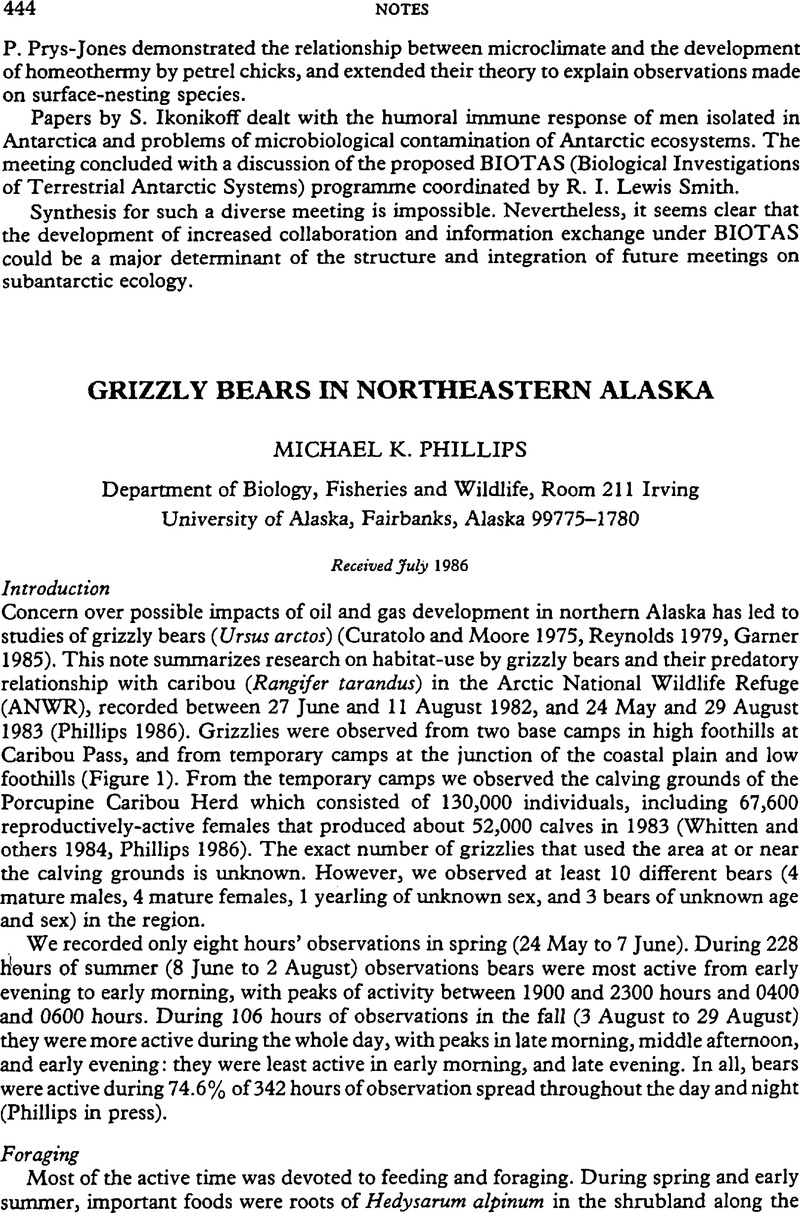No CrossRef data available.
Article contents
Grizzly bears in northeastern Alaska
Published online by Cambridge University Press: 27 October 2009
Abstract
An abstract is not available for this content so a preview has been provided. Please use the Get access link above for information on how to access this content.

Information
- Type
- Notes
- Information
- Copyright
- Copyright © Cambridge University Press 1987
References
Craighead, J. J. and others.1976. Reproductive cycles and rates in the grizzly bear (Ursus arctos horribilis) of the Yellowstone ecosystem. International Conference on Bear Research and Management 3(1): 337–56.Google Scholar
Cole, G. F. 1972. Grizzly bear-elk relationships in Yellowstone National Park. Journal of Wildlife Management 36(4): 556–61.CrossRefGoogle Scholar
Curatolo, J. A. and Moore, G. D. 1975. Home range and population dynamics of grizzly bear (Ursus arctos L.) in the eastern Brooks Range, Alaska. In Jakimchuk, R. D. (editor) Studies of large mammals along the proposed MacKenzie Valley gas pipeline route from Alaska to British Columbia. Arctic Gas Biological Report Series 32: 1–79.Google Scholar
Follmann, E. H. and others.1980. Recommended carnivore control program for the northwest Alaskan pipeline project including a review of human- carnivore problems and animal deterrent methodology. Northwest Alaskan Pipeline Company, Contract No 478085–9-K071.Google Scholar
Garner, G. W. and others. 1985. Ecology of brown bears inhabiting the coastal plain and adjacent foothills and mountains of the northeast portion of the Arctic National Wildlife Refuge. In Garner, G. W. and Reynolds, P. (editors) 1984 update report: baseline study of the fish, wildlife, and their habitats. US Fish and Wildlife Service, Anchorage, Alaska: 268–96.Google Scholar
Hamer, J. D. W. 1985. Feeding ecology of grizzly bears in the Cascade and Panther Valleys of Banff National Park. PhD dissertation, University of Calgary, Alberta.Google Scholar
Klein, D. R. 1979. Alaska oil pipeline in retrospect. Transactions of the North American Wildlife and Natural Resources Conference 4(1): 235–46.Google Scholar
Phillips, M. K. 1986. Behavior and habitat use of grizzly bears in northeastern Alaska. MS thesis, University of Alaska, Fairbanks.CrossRefGoogle Scholar
Phillips, M. K. in press. Summer and fall activity patterns of grizzly bears in northeastern Alaska. Canadian Field-Naturalist.Google Scholar
Reynolds, H. V. 1979. Population biology, movements, distribution, and habitat utilization of a grizzly bear population in NPR-A. In Lent, P. (editor) Studies of selected wildlife, fish, and their use of habitats on and adjacent to NPR-A 1977–78. US Department of Interior, Anchorage, Alaska. 1: 129–82.Google Scholar
Reynolds, H. V. and Garner, G. W. in press. Patterns of grizzly bear predation on caribou in northern Alaska. International Conference on Bear Research and Management.Google Scholar
Schleyer, B. O. 1983. Activity patterns of grizzly bears in the Yellowstone ecosystem and their reproductive behavior, predation, and the use of carrion. MS thesis, Montana State University, Bozeman.Google Scholar
Stelmock, J. J. 1981. Seasonal activities and habitat use patterns of brown bears in Denali National Park. MS thesis, University of Alaska, Fairbanks.Google Scholar
Spraker, T. H. and others. 1981. Game management unit 13 brown bear studies. Alaska Department of Fish and Game, Federal Aid Wildlife Restoration Project No W–17–10, W–17–11 and W–21–1, Job No 4.13R.Google Scholar
Whitten, K. L. and Cameron, R. D. 1984. Calving distribution and initial productivity in the Porcupine caribou herd, 1982. In Garner, G. W. and Reynolds, P. (editors) 1983 update report: baseline study of the fish, wildlife, and their habitats. US Fish and Wildlife Service, Anchorage, Alaska: 359–420.Google Scholar

